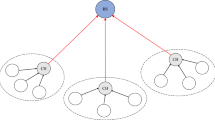Abstract
Along with the advancement in wireless communications and electronics, in this paper, we first propose a novel application problem in wireless sensor networks. It is the data forwarding of real-time mobile target tracking problem. We mainly focus on the researches of the strategy of routing the tracking data to several sinks with the consideration both of energy conservation and latency limitation. We propose three different heuristic methods [minimum latency routing, maximum utilization routing and active first routing (AFR) respectively] to research and compare their performance for solving the problems. We also use the traditional Dijkstra’s shortest path algorithm to get the lower bound of the latency limitation. As a result, we found that the AFR algorithm is better than others, it achieves the similar latency limitation with Dijkstra’s and it get a 1.2–1.5 times of energy conservation than other algorithms regardless of energy supplement conditions. It is an optimal algorithm for this problem.






Similar content being viewed by others
References
Akkaya K, Younis M (2005) A survey on routing protocols for wireless sensor networks. Ad Hoc Networks 3(3):325–349
Azim MA, Kibria MR, Jamalipour A (2009) An optimized forwarding protocol for lifetime extension of wireless sensor networks. Wirel Commun Mob Computing 9(1):103–115
Dijkstra EW (1959) A note on two problems in connexion with graphs. Numerische Mathematik 1:269–271
Garey M, Johnson D (1979) Computers and intractability: a guide to the theory of NP-completeness. Freeman, New York
Hedetniemi SM, Hedetniemi ST, Liestman AL (1988) A survey of gossiping and broadcasting in communication networks. Networks 18(4):319–349. doi:10.1002/net.3230180406
Heinzelman W, Chandrakasan A, Balakrishnan H (2000) Energy-efficient communication protocol for wireless microsensor networks. In: Proceedings of the 33rd Annual Hawaii International Conference on System sciences, 2000, pp 3005–3014
Heizelman W (2000) Application specific protocol architectures for wireless networks. Ph.D thesis, MIT
Intanagonwiwat C, Govindan R, Estrin D (2000) Directed diffusion: a scalable and robust communication paradigm for sensor networks. In: Proceedings of the 6th annual international conference on Mobile computing and networking, MobiCom ’00, pp 56–67
Kulik J, Heinzelman W, Balakrishnan H (2002) Negotiation-based protocols for disseminating information in wireless sensor networks. Wirel Netw 8:169–185
Lindsey S, Raghavendra C (2002) Pegasis: power-efficient gathering in sensor information systems. In: Aerospace Conference Proceedings, 2002. IEEE, vol 3, pp 1125–1130
Liu L (2008) Energy conservation in wireless sensor networks and related problems of graph theory. Ph.D thesis, Universite Paris-sud
Manjeshwar A, Agrawal D (2001) Teen: a routing protocol for enhanced efficiency in wireless sensor networks. In: Parallel and Distributed Processing Symposium., Proceedings 15th International, pp 2009–2015
Meng T, Rodoplu V (1998) Distributed network protocols for wireless communication. In: Proceedings of the 1998 IEEE International Symposium on Circuits and systems, 1998. ISCAS ’98, vol 4, pp 600–603
Ni LM, Liu Y, Lau YC, Patil AP (2004) Landmarc: indoor location sensing using active rfid. Wirel Networks 10:701–710
Rodoplu V, Meng T (1999) Minimum energy mobile wireless networks. IEEE J Sel Areas Commun 17(8):1333–1344
Salhieh A, Weinmann J, Kochhal M, Schwiebert L (2001) Power efficient topologies for wireless sensor networks. In: International Conference on Parallel Processing, 2001, pp 156–163
Shiloach Y (1978) The two paths problem is polynomial. Tech rep, Stanford, CA, USA
Shiloach Y, Perl Y (1978) Finding two disjoint paths between two pairs of vertices in a graph. J ACM 25:1–9
Siegemund F, Florkemeier C (2003) Interaction in pervasive computing settings using bluetooth-enabled active tags and passive rfid technology together with mobile phones. In: Proceedings of the First IEEE International Conference on Pervasive computing and communications, 2003 (PerCom 2003), pp 378–387
Singh S, Woo M, Raghavendra CS (1998) Power-aware routing in mobile ad hoc networks. In: Proceedings of the 4th annual ACM/IEEE international conference on Mobile computing and networking, ACM, MobiCom ’98, pp 181–190
Sinha A, Chandrakasan A (2001) Dynamic power management in wireless sensor networks. IEEE J Des Test Comput 18(2):62–74
Yick J, Mukherjee B, Ghosal D (2008) Wireless sensor network survey. Comput Networks 52:2292–2330
Author information
Authors and Affiliations
Corresponding author
Rights and permissions
About this article
Cite this article
Yang, Y., Li, L. & Li, H. Data forwarding of realtime mobile target tracking in wireless sensor networks. J Ambient Intell Human Comput 4, 109–120 (2013). https://doi.org/10.1007/s12652-012-0106-2
Received:
Accepted:
Published:
Issue Date:
DOI: https://doi.org/10.1007/s12652-012-0106-2




